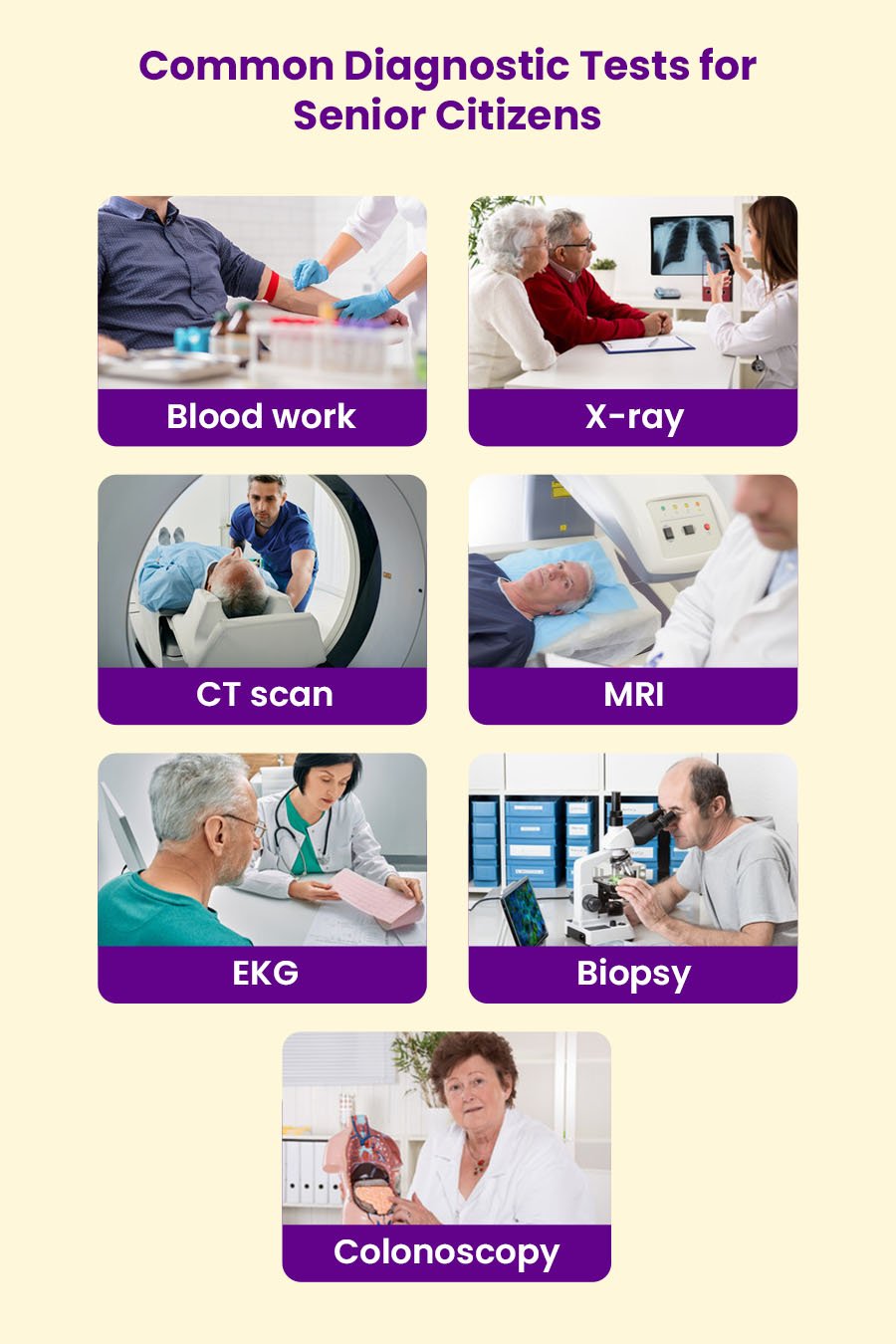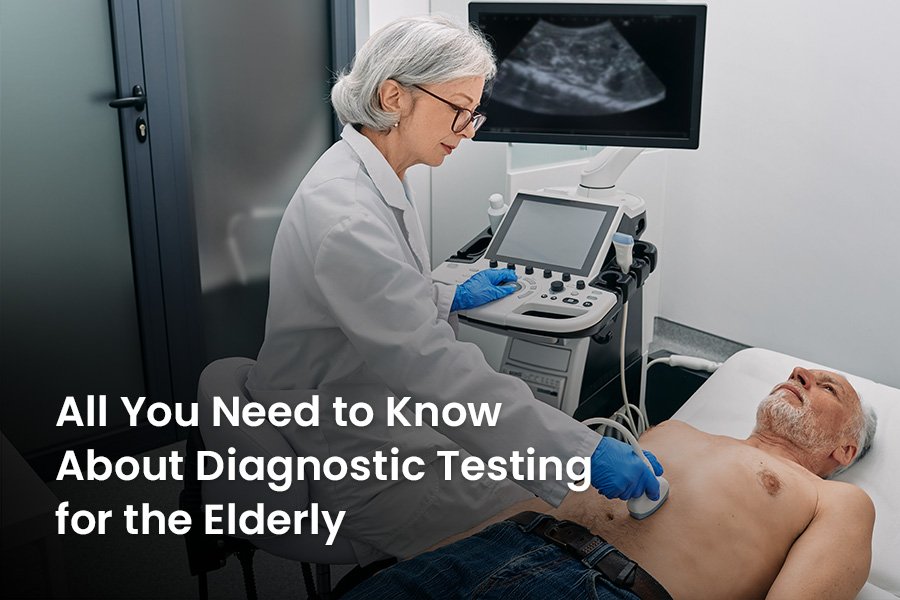A diagnostic test is used to confirm or rule out a condition or disease based on a set of symptoms. It can also help plan a course of treatment, evaluate its outcome and prognosis. Diagnostic testing uses various tools to track the progression of the disease and helps manage it better. Diagnostic testing is absolutely crucial in certain cases as treatment based on false diagnosis can be potentially fatal in many diseases. (Correct diagnosis crucial for correct treatment and recovery)
Types of Diagnostic Testing
- Invasive Diagnostic Testing
- Non-invasive Diagnostic Testing
Invasive diagnostic testing entails puncturing the skin or entering the body using medical instruments or devices. Whereas non-invasive testing uses imaging to get a look at the organs and bones without cutting through the skin. For certain diseases like cancer, both non-invasive and invasive diagnostic testing may be required to determine its type and prognosis.
Common Diagnostic Tests for Senior Citizens

Physicians routinely order a variety of invasive and non-invasive diagnostic tests during health check-ups for the elderly. Here are the most common diagnostic tests that older adults may need:
Blood Work
Blood work is an important diagnostic tool that can help assess seniors’ general wellbeing and detect underlying health conditions early. The most common blood panels used for older adults are complete blood count (CBC) tests and basic metabolic panels. CBC tests help measure the number of white blood cells, red blood cells, haemoglobin and platelets per microliter of blood. Basic metabolic panels, on the other hand, help measure glucose, sodium, potassium, chloride and creatinine levels in the body. Physicians at EliteCare Health Centers in Florida provide consultation and diagnostic services like blood draws and EKG. Other blood tests like lipid profile test, thyroid stimulating hormone test and liver function tests can help measure and enable evaluation of cholesterol levels, hormones, enzymes and proteins in the blood.
X-ray
X-ray is an indispensable tool in diagnosing the medical conditions of senior citizens as it is non-invasive, painless and quick. X-ray can reveal underlying issues that may otherwise go undetected, such as osteoporosis and arthritis. It can also be used to diagnose pneumonia and certain types of cancers.
CT Scan
Computed Tomography Scans can accurately detect and monitor early signs of cancer and heart disease in the elderly. In some cases, it can also detect internal injuries and bleeding. Seniors that can’t withstand the adverse effects of some of the more invasive imaging procedures can opt for CT scans as they are painless, efficient and relatively quieter than some of the other imaging techniques. It also uses significantly less radiation than X-rays which can be helpful for seniors that may be sensitive to radiation exposure.
MRI
Magnetic Resonance Imaging is used for diagnosing diseases like Alzheimer’s, Parkinson’s and other neurological disorders. An MRI provides detailed images of the body’s organs and soft tissue which can help identify and detect underlying health problems, such as tumor and vascular diseases early. Senior citizens with weakened immune systems could especially benefit from MRI scans as it doesn’t use any radiation.
EKG
An electrocardiogram helps detect changes in heart rhythm and monitors arrhythmias and other cardiac conditions. It can also evaluate the effectiveness of medication and track changes in heart health over a long period of time. Additionally, EKG can help detect blockages in the major arteries. Elderly people who are at risk for heart diseases and are suffering from high blood pressure, high cholesterol or diabetes are recommended to get an EKG done annually.
Biopsy
Biopsies are medical procedures that involve taking a sample of tissue from a patient’s body for testing. Although imaging tests like CT scans and MRIs are useful for finding lumps or abnormal tissue, they are unable to distinguish between cancerous and non-cancerous cells on their own. For most cancers, the only way to make a diagnosis is to conduct a biopsy to gather cells for further analysis. Additionally, biopsies can also help identify or track the development of chronic illnesses like arthritis or heart disease. If a biopsy is necessary, the doctor will discuss the risks and benefits with the patient and decide which type of biopsy is best for their individual case.
Colonoscopies
A colonoscopy is a procedure that allows a doctor to visually examine the inner lining of the large intestine. During the procedure, a long flexible tube called colonoscope is inserted into the rectum. The tiny camera at the tip of the tube allows the doctor to view the entire colon from the inside and remove polyps or other growths. Small samples of tissue (biopsies) can also be gathered during colonoscopies. Colonoscopies are recommended for older adults over the age of 60, as they are at a higher risk of developing colorectal cancer. It is important to note that in order to get a colonoscopy, a patient must first be screened for any other underlying conditions or factors that may increase their risk of colorectal cancer.
The number of diagnostic tests and tools available have increased exponentially in recent times. WHO lists 113 essential diagnostic tests to improve diagnosis and treatment outcomes. Among them, 58 tests are for detection and diagnosis of a wide range of common diseases. These tests can help physicians screen illnesses in the elderly and manage them ahead of time.
Conclusion
To establish effective treatment plans for patients, physicians need access to accurate and efficient diagnostic procedures. Senior citizens no longer need to put off visiting the hospital for health challenges as many diagnostic tools are painless and safe. Diagnostic testing provides preventative care as it detects warning signs for deadly illnesses early. Older adults over the age of 60 must get annual health check-ups each year to stay on track of their physical health and reduce potential health-risks associated with ageing and chronic diseases.










